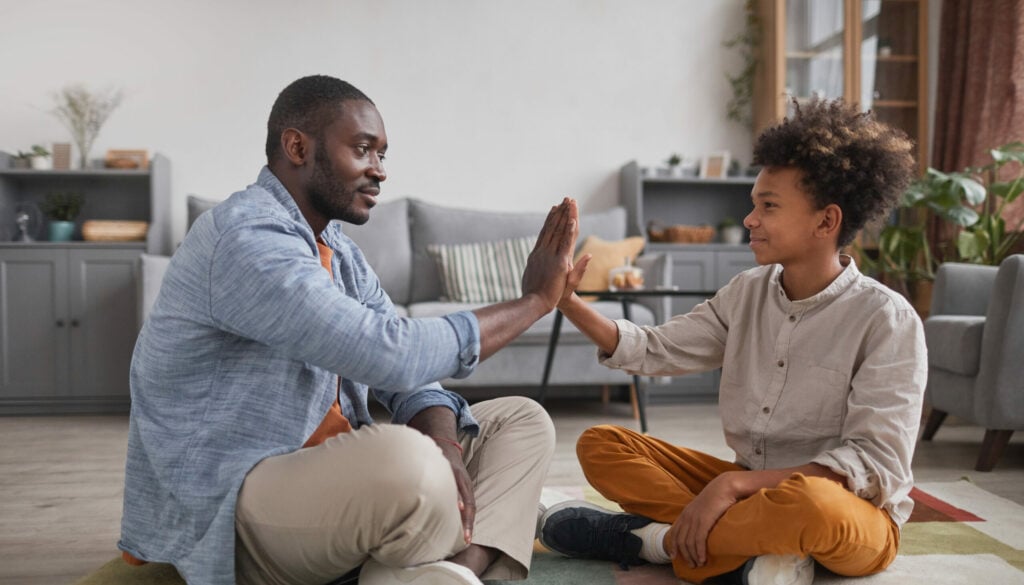What if divorce is the best thing you can do for your kids?
Reviewed by Stephanie Steinman, PhD, CSAC


As divorce rates started to rise in the 1960s, the end of a marriage was considered the absolute worst thing to happen to a family. If you came from a “broken home,” you were seen as much more likely to be an unhappy child, to drop out of school, and even to commit crimes.1


Patricia, an educator in her early 50s, doesn’t remember her parents announcing their divorce. Instead she recalls a slow dismantling of their marriage over the course of several years, ending when she was in college.
“It was definitely a high-conflict marriage,” she says. “They fought often and ruined many holidays and events.” She and her siblings were relieved when they finally split up.
Now happily married herself, Patricia says her parents left her with a good sense of what a relationship should be based on the flaws in theirs: “I learned early on what I didn’t want in a marriage.”
Divorce doesn’t have to be catastrophic. In fact, if you end your marriage with thoughtfulness and care, it can actually make you—and your kids—much happier. So why are we still so scared of divorce?
Secure your own oxygen mask first
In many circles, it’s seen as taboo for parents to put our needs before those of our children. But what if an increase in our happiness could benefit theirs?
Steven O’Brien, PsyD, specializes in counseling kids and families through divorce. He notes that research shows when parents have greater contentment and lower levels of depression and anxiety, “they are going to parent in a way that is more relaxed and more comfortable.” This mindset improves their kids’ lives, too.
Depressed parents in unhappy marriages, on the other hand, are more likely to see their children develop behavioral and mental health problems.2
Then there’s the common trope of staying together “for the sake of the kids.” Whether or not that’s actually beneficial depends on the couple, O’Brien says. This arrangement can work, but only in “low-conflict situations where parents have enough agreement on parenting and a high level of civility,” he explains—and even then it should only be considered for short periods of time, with the support of a mental health professional.
The impact of divorce at different ages
O’Brien defines four age groups in which kids tend to respond to divorce in certain ways, depending on their development.
Little ones (0 to 8): Children in this age group thrive on routine, O’Brien says: “Consistency gives them a lot of security. They feel like they know what to expect.” As a result, kids age eight and under may experience stress and anxiety at the idea of their daily routines being disrupted by divorce. Letting them know their schedule ahead of time can be a big help.
Rachel, a parent and instructional aide in her mid-40s, fell into this group. Her parents split up when she was only three, leaving her with almost no memories of them together. But they had a friendly relationship after the divorce and put a strong focus on keeping her and her brother’s day-to-day lives the same. Like Patricia, Rachel felt her parents benefited from the divorce and were much happier apart.
Middle schoolers (8 to 12): Middle schoolers worry about details like getting to activities on time and which parent will be at which school function. This concern can lead to depressive features and anxiety, says O’Brien, especially at the younger end of the range. Kids on the older end tend to be more egocentric. “They’re more likely to think ‘Maybe this works for you guys, but it doesn’t work for me,’ so they’re much more likely to have anger outbursts,” he says. Recognizing the stress they’re going through and giving them space to share their feelings can help children this age process a challenging situation.
Teenagers (13 to 17): This group can be harder to predict. “How they react depends on how mature they are as individuals, but also on their perception of their parents’ marriage,” says O’Brien. “Sometimes they see their parents’ divorce as a good thing, especially if there’s been a lot of fighting.” However, like middle schoolers, teens are still very concerned with their own needs and desires. One-on-one conversations with your teen can be helpful, especially if you’re in the car or another setting where they can talk without having to make direct eye contact.
Young adults (18 and up): O’Brien says this group is mostly focused on their parents’ well-being and how the family will interact and care for each other. Sharing some of your own feelings with emerging adults can help address their concerns. Patricia was in this age range when her parents divorced, and she says the new family dynamic did take some adjusting to. “I remember my mom had to move in with her dad, so at first our living arrangements shifted,” she says. Once the logistics were settled, though, her family embraced their new normal.
Getting ready for the big conversation
The decision to divorce may have taken you and your spouse months or years to reach. But your children may not have been aware at all, especially if they’re young. This can leave them unprepared for and even shocked by the news. O’Brien says there are ways to soften the blow.
Find out where your child is developmentally. O’Brien recommends meeting with a child psychologist or a therapist who works with families to have your child evaluated so you can know what to expect. Your school psychologist may also be able to shed some light on your child’s developmental readiness.
Have a plan, but don’t tell them too early. Children under five, says O’Brien, have no concept of time, “so you want to tell them when there are only a few weeks before a specific change like a parent moving out.” Tying the concept of divorce to an action like a parent going to a new home can save the child a lot of stress. Older kids can handle more time to sit with the idea—but again, O’Brien says, too much time may cause needless anxiety. The more concrete facts you can give right away about where the kids will live and what their routines will look like, the better.
Get ready for the “why.” Most children will want to know why this is happening, so parents must be prepared to answer. “The ‘why’ can mean different things at different ages,” O’Brien says. “The older the kid, the more it really means, ‘What’s the explanation?’ For younger kids, ‘why’ means ‘I don’t like this.’” Giving kids vague explanations like “We’re not in love anymore” doesn’t help. Instead O’Brien suggests that after answering once, you should move into validating your child’s feelings by saying something like, “I know this feels terrible. I know you don’t want this to happen, and I’m sorry.”
How therapy can help you navigate divorce
You may want to go to therapy on your own, with your spouse, and with your kids during the whole divorce process, O’Brien says. The guidance of a mental health professional can benefit your entire family.
To start, O’Brien recommends pairing individual therapy with parent consultation. “Therapists take a risk when they start working with a family and don’t have enough of a sense of where the kid is at emotionally and developmentally, as well as where the parents are emotionally,” he says.
O’Brien meets with the parents and the child separately before he considers meeting with the family all together. This lets him gauge how the parents communicate and where they stand in terms of unresolved anger, which also helps him assess the child’s home environment. With all this information about how the parts act separately, O’Brien says, a therapist can conduct a family session while understanding them as a whole.
The keys to healthy coparenting
Coparenting can be difficult, especially when a divorce is contentious or not mutually wanted. Even so, O’Brien says, there are steps you can take to help ease your child’s experience.
Take care of your own needs. When parents have unresolved anger or pain, it makes it more challenging to coparent. “That’s when you have to put on your own oxygen mask before helping anyone else,” says O’Brien. “You may need some therapy to work through your own emotional state, or you’re not going to coparent well.”
When Tina and her husband decided to end their 17-year marriage, she sought out therapy and was glad she did. “My therapist helped me see the bigger picture when I couldn’t,” says Tina, who’s 50 and also works in education. One idea especially resonated: “You think right now that who has the kids on Christmas or Thanksgiving matters the most,” she says. “It doesn’t. What matters is who shows up day after day.” She credits this guidance from her therapist with helping her maintain perspective.
Work to build a civil, low-conflict relationship. Tina made the conscious decision that she and her ex would care for each another as coparents. “When he moved, I went over and hung curtains and helped set up his house, and he does stuff like that for me,” she says. “We really do try to take good care of one another.” Across all age groups, another important tip is to avoid saying negative things about your ex to your kids.
Leave room for different parenting styles. “It’s naive to think you will parent exactly the same,” O’Brien says, “so you need to come to a place where you accept the other’s style of parenting and trust that they have your child’s best interests at heart.”
Tina and her ex faced some early conflicts in this area. Because his job keeps him out of town much of the week, Tina says she is the more connected, hands-on parent. She doesn’t always understand or agree with her ex’s parenting style, but she knows that in the end, he’s a good dad with good intentions for their kids.
Redefining family
At first Tina was surprised when her ex-husband got engaged only a year after their divorce, but she has come to embrace the woman she calls Bonus Mom. “He chose a lovely woman to marry,” she says, “so it was easy for me to accept her as one more person to love my children.”
Their divorce was hard on everyone, and they did a lot of mourning, but Tina believes that ultimately the split made their family stronger. Her ex is happy with Bonus Mom, and Tina is pursuing her dream of making music. Their kids are in college or heading there soon, and they’ve processed the divorce with the help of therapy and by finding their own passions.
Now the pictures on their fridges include six people instead of five, and there’s another voice cheering the kids on. The shape and size of their family may have changed, but they all show up for each other when it counts—and that, Tina says, is what truly makes them a family.

Sources
About the author
Amye Archer, MFA, is the author of “Fat Girl, Skinny” and the coeditor of “If I Don’t Make It, I Love You: Survivors in the Aftermath of School Shootings,” and her work has appeared in Creative Nonfiction magazine, Longreads, Brevity, and more. Her podcast, “Gen X, This Is Why,” reexamines media from the ’70s and ’80s. She holds a Master of Fine Arts in creative nonfiction and lives with her husband, twin daughters, and various pets in Pennsylvania.
Related articles

To end violence against teen girls, start with teen boys
Teen girls are reporting more assaults, mainly by boys their age. How can we...

Why you and your teenager both need a therapist
It’s crucial to support your teen’s mental health—but don’t forget...

To stay together forever, get a sleep divorce
One in five couples sleep in separate rooms. So why do we still feel so weird...

Child life specialists: What they do and how they can help
Find out what child life specialists do and how they can help support kids and...
